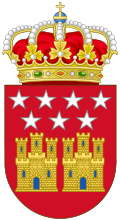| History of the coat of arms of Madrid Province |
| Coat of arms | Dates | Details |
|---|
 | 1872–1873
1874 – c.1920 | The first version of Madrid Province quarterings and a central inescutcheon were standing for: |
 | 1873–1874 | During the First Republic, the heraldic open royal crown was replaced by a mural crown. [6] |
 | c.1920–1931 | Later, reigning King Alfonso XIII, in the third quarter were added the 'ancient' arms of San Lorenzo de El Escorial (Habsbourg, Austria and Lorraine). In the inescutcheon were also introduced the griffin and the civic crown that had been included in the arms of Madrid City in 1859. The 'ancient' open royal crown was replaced by the Spanish Royal Crown. An example of this achievement can still seen today on the front facade of Las Ventas Bullring. [7] [8] |
 | 1931–1939 | During the Second Republic, the Spanish Royal Crown was replaced by a mural crown and the coronets of the heraldic lions of San Lorenzo de El Escorial and Chinchón were also removed. [9] |
 | 1939–1968 | In the Francoist period, the coronets of the heraldic lions were restored, a female bust was introduced over the aqueduct of Navalcarnero and the mural crown was replaced by the heraldic open royal crown as was displayed with the monarchy from 1872 to c.1920. [10] |
 | 1968–1977 | Madrid's provincial division was later rearranged into only five judicial districts, and a new coat of arms was considered, with five quarterings and a central inescutcheon standing for: - 1 Alcalá de Henares (a triple-towered castle over waves)
- 2 Navalcarnero 'modern' (an aqueduct)
- 3 San Lorenzo de El Escorial 'modern' (per pale a grill and per fess Austria and France modern)
- 4 Colmenar Viejo 'modern' (arms based on the heraldry of Santillana-Vega-Luna family)
- 5 Aranjuez (1st division: the Cross of St James, 2nd division: a palace over waves)
- 6 (inescutcheon) Madrid 'ancient' (in fact, modern because in 1967 the griffin and the civic crown were removed) and the five-pointed stars became six-pointed according to the 1939 version of the city arms. [11] [12]
|
 | 1977–1983 | In 1977, after King Juan Carlos's accession to the throne, the heraldic open crown used by Franco's regime was replaced by the Spanish Royal Crown and the traditional Iberian escutcheon shape was introduced. [12] |








